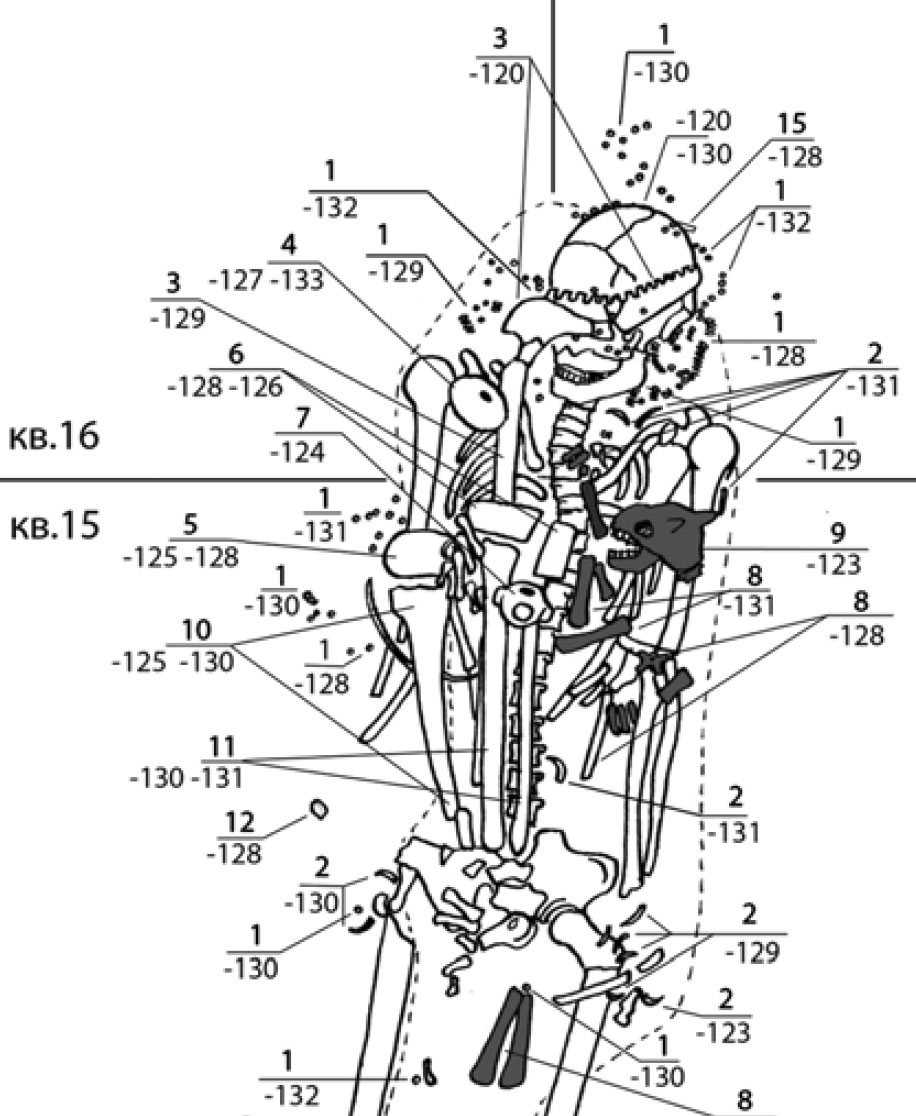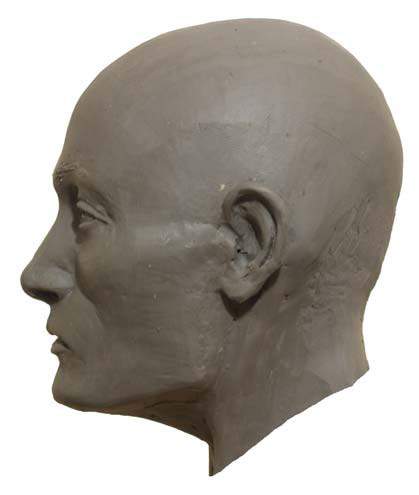Recent paper (behind paywall) The Unique Burial of the Ekaterinovsky Cape Early Eneolithic Cemetery in the Middle Volga Region, by Korolev et al. Stratum Plus (2018) Nº2.
Abstract (official, in English):
This is the first time we published the results of a comprehensive study of burial 45 of the eneolithic cemetery called Ekaterinovsky Cape. The burial contains the skeleton of a young man with traumatic injuries of the skull, leg and hand bones of other individuals, skeleton of a young specimen of a domestic goat (Capra hircus) that was abundantly sprinkled with red ocher. Grave goods include three stone scepters of different types, a large item made of horn in the shape of a bird’s head, a stone adze, knife-like plates of quartzite, beads from the flaps of the shells (Unio), marmot cutters, decoration made from a beaver’s tooth. The uniqueness of the burial is determined by the combination of the composition of the grave goods and traces of ritual practices. To conclude, we suggest the buried man could belong to the elite of the society that left this burial ground.
NOTE. About my terminology, Russian has a lenited pronunciation of E in this case, hence the “Ye-” transliteration of the name of the town (and the site) in Google as Yekaterinovka. The “more etymological” transliteration is with “E”, as they use here, although Russians paradoxically use phonetic transliterations of foreign terms. I prefer the lenited transliteration to distinguish the Russian site from other Ekaterinovkas, though.

Interesting excerpt (translated from Russian):
Perhaps, we should correlate three very closely related damages [on the skull] with certain rituals, with which scepters could be associated. Each scepter could be a symbolic expression of a part of society, a type of activity, reaching a certain age and social status. This assumption does not seem incredible in combination with other extant, no less impressive, details of the funeral rite. Of great interest is the ornithomorphic rod of the horn. The location of the wand in the head and right half of the breast emphasizes its special significance in ritual practice and in funeral rites. Direct analogies to this product in other burial places of the cemetery are absent, and outside it authors are not known.
NOTE. Although the paper is in Russian and is behind paywall, it is really cheap, and can be easily translated with Google Translate if you can’t read Russian, so – unlike usual papers from the big publishing companies – you could support the journal by paying for it. You can read more about this burial at Pikabu, too. Photos and text in that post are not the same as in the paper, though, so it seems that the author of the text got the information either directly or from another source.
On the genetic data
Here is what I could gather about the report I shared of R1b-L51 lineages in Samara:
1) Yes, the comment at MolGen.org contains a more or less accurate summary of the oral communication actually given. And no, no more interesting data – from a genetic point of view – was presented.
2) What A.A. Khokhlov reported was preliminary genetic information from some samples, and an outside lab shared this information with him.
NOTE. It is well-known that David Anthony, also part of the Samara Valley project, provided the Reich Lab with Khvalynsk and Yamna samples from the region, so it would not be a surprise that these had been in fact assessed by the Reich Lab, too. This is my assumption, though, and I may be wrong.
3) What the report conveys is that “all samples investigated” belonged to R1b-P312 and R1b-U106, so I understand there are in principle more than two samples, whatever Google Translate says.
4) As R. Rocca said in Anthrogenica, the reported R1b1a1a2a1a1c2b2b1a2 (U106 subclade) is exactly the same one reported in Narasimhan et al. (2018) for the sample from the Iron Age site Loebanr 1 (Swat proto-historic graves) ca. 950 BC.
NOTE. That would be another hint at the origin of the preliminary data, together with the timing of the report (January), probably coinciding with the final assessment of samples which appeared in Narasimhan et al. (2018). That would explain the similar weird Y-SNP calls from software yHaplo (as reported by Narasimhan in Twitter). This is all again conjecture, though.
R1b-P312 is not reported in Narasimhan et al. (2018) for any sample (that would be “R1b1a1a2a1b”, following the standard used in their tables). Because the V88 sample in Khvalynsk, as well as other previously known V88 samples, are correctly reported as within the V88 branch, we may be talking about anything in the R1b tree from L754 (xV88) on. Most likely at or beyond the subclade of the Zvejnieki sample of hg R1b1a1 (classified as of R1b1a1a2a1), i.e. from P297 on.
NOTE. Since R1b-Z2103 samples are correctly reported, it is unlikely that the reported samples are from this branch, either.

It is possible, then, that we will have haplogroup R1b-M269 or L23 instead of L51, after all, and there would be then no major corrections to be made, either to the estimated dates from McDonald or Yfull (with their current differences), or to my predictions for early and late Khvalynsk, Repin, and Yamna…
NOTE. In fact, the appearance of R1b-M269* and/or L23* linked to expanding Khvalynsk could be the perfect end to the resurging theories on Armenian or Western European origin of this haplogroup.
5) The full official genetic data is expected within a year (precise date unknown), so unless someone knows of a related draft in the making (which could publish them earlier), I would keep my expectations low for an official confirmation of the precise subclade any time soon.
NOTE. The best likely proxy for the reported data, if the above assumptions on Y-SNP calls and the software used are correct, is therefore to check out – whenever the corrected tables are published – the samples in Narasimhan et al. (2018) now classified as of R1b1a1a2a1(-) subclades. Or to experiment with the software and available BAM files to see which ones give this result…
6) I don’t know if Khokhlov’s book on Samaran archaeology will contain a reference to the samples, but I doubt it could contribute much more to the genetic data.
The meaning of Yekaterinovka
Of course, the Yekaterinovskiy Cape burials are just a tiny sampling of the dozens of settlements known from Khvalynsk, and the known ones represent just a tiny part of the hundreds that the culture probably had while it developed for more than a thousand years. In that sense, you may say that it is statistically not significant.
Nevertheless, as Anthony’s team recently said when explaining the relevance of their findings at Radzorskoe, the potential implications of any discovery at any of the few studied sites are very important. In this case, by confirming that late Khvalynsk became dominated early by R1b-M269, as was later Yamna, and as were early Yamna offshoots like Afanasevo and Bell Beaker.
I really don’t have anything more to add, whether in comments or per email. That’s as much information and speculation as you can get from me (or from them, I guess). If you want more, you can write to the team members yourselves.
Related:
- Haplogroup R1b-L51 in Khvalynsk samples from the Samara region dated ca. 4250-4000 BC
- Domestication spread probably via the North Pontic steppe to Khvalynsk… but not horse riding
- Differing modes of animal exploitation in North Pontic Eneolithic and Bronze Age Societies
- North Pontic steppe Eneolithic cultures, and an alternative Indo-Slavonic model
- The Lower Danube during the Eneolithic, and the potential Proto-Anatolian community
- The Indo-European demic diffusion model, and the “R1b – Indo-European” association
- Proto-Indo-European homeland south of the Caucasus?
- On the potential origin of Caucasus hunter-gatherer ancestry in Eneolithic steppe cultures
- Consequences of O&M 2018 (II): The unsolved nature of Suvorovo-Novodanilovka chiefs, and the route of Proto-Anatolian expansion
- New Ukraine Eneolithic sample from late Sredni Stog, near homeland of the Corded Ware culture